|
|
|
|
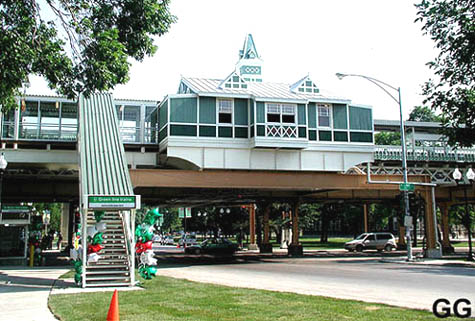 The Conservatory -- Central Park Drive inbound station house, looking north on opening day, Saturday, June 30, 2001. Note the balloons on the stairs celebrating the station inauguration. For a larger view, click here. (Photo by Graham Garfield) |
|
|
|
|
 The Conservatory -- Central Park Drive inbound station house, looking north on opening day, Saturday, June 30, 2001. Note the balloons on the stairs celebrating the station inauguration. For a larger view, click here. (Photo by Graham Garfield) |
Conservatory -
Central Park Dr (3600W/100N)
Lake Street and Central
Park Drive, East Garfield Park
Service Notes:
Green Line: Lake
Accessible Station
Quick Facts:
Address: 3630 W. Lake Street
Established: June 30, 2001
Original Line: n/a
Skip-Stop Type: n/a
Rebuilt: n/a
Status: In Use
History:
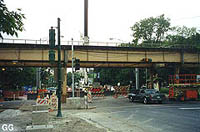 A view of the construction of the Conservatory station, looking north on Central Park Avenue on August 9, 2000. Footings for additional station structure can been seen in the left side foreground. Click here for a larger view. (Photo by Graham Garfield) |
Background
In 1997, the CTA unveiled a plan to deconstruct the historic Homan station -- one of the original stops on the Lake Street Elevated Railroad that was opened for service in 1893, when trains were pulled by steam locomotives -- and reassemble its outer shell two blocks west at Central Park Drive, which would give the line's stations equal spacing, but which lacks a bus route (but which Homan has, the #82 Kimball-Homan). (Ed.: Read all about it in articles in either the Chicago Tribune or the Chicago Sun-Times.)
 The structure for the platform and canopy on the westbound side are nearly complete in this view looking southeast from the corner of Lake Street and Central Park Avenue on January 5, 2001. Click here for a larger view. (Photo by Graham Garfield) |
The construction of the new Conservatory-Central Park station (or rather "reconstruction") advanced relatively quickly. Twenty-one concrete piers were in place as of June 2000, as were all four stair foundations. Steel fabrication began then and the first delivery of structural steel began in July.
The project was delayed 114 days, however, and the projected opening date for the station has been moved from February 6 to May 31, 2001. It seems that while digging for the elevator shafts, CTA crews encountered high-voltage cable belonging to the Chicago Park District. The CTA did a redesign and moved some pylons away so that work could continue, but moving the elevators proved to be cost-prohibitive. Therefore, crews had to wait until the cables could be relocated before that part of the construction could continue.
The decking for the former
Homan
station is in place, as are the platform and transfer bridge
structures and elevator towers, looking north on January 5,
2001. Click here
for a larger view. (Photo by
Graham Garfield)
As of January 2001, the basic structure for the station was
in place. The steel structural skeleton of the platforms and canopies
were constructed. The platform began at the intersection of Lake and
Central Park and extended eastward for just over a block. Auxiliary
entrance/exit stairs were built at the east end of the platforms and
were complete by this date. The elevator towers were nearing
completion at this point and work on the overhead transfer bridge
connecting them was underway. The supports and decking over the
Central Park Drive that would hold the old Homan
station structure was also in place, indicating that reassembly of
the old 1893 metal Queen Anne station could begin shortly.
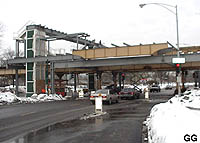
By March, the steel structure and wooden decking of the new platforms was completed, as were the steel canopies that approximate the design of the old Lake Street "L"'s peaked canopies. Reassembly of the historic Homan station house structure began and the basic form of the historic inbound and outbound station houses were completed by the end of the month, at which time the roof purlins and sheathing on the station houses began to be added. Refurbished canopy columns from the old Homan station and the station roof dormers were then installed. During April, light channels and hand railings were installed on the platforms and the construction of the inbound and outbound station houses, stairs, canopy steel, electrical work, and elevators continued. Also completed were the elevator towers, pedestrian crossover bridge, and the open web platform sections of the old Homan station house. The auxiliary stairs at the east end of the station were also complete.
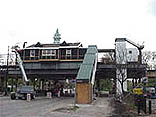 Looking south on Conservatory Drive, the Queen Anne form of the old Homan station house is clearly taking shape at the outbound Conservatory station house in April 2000. (Photo from the CTA) |
Opening Ceremony
Above: CTA President
Kruesi speaks at the opening, with Chairman Jarrett and
Mayor Daley behind, on June 30, 2001. For a larger view,
click here.
(Photo by Graham Garfield) Below: Mayor Daley
enjoys the new station with Chairman Jarrett on June 30,
2001. The CTA's Historic Train is behind. For a larger view,
click here.
(Photo by Graham Garfield)
The opening date for the new Conservatory-Central
Park Green Line station was set for Saturday, June 30, 2001. The
station was brought into public service at 0600 hours that morning.
There was an opening ceremony and press conference at the station at
10am with CTA Chairman Valerie B. Jarrett and President Frank Kruesi,
Mayor Richard M. Daley, the local alderman, and others. Traditional
speeches were made in celebration of the opening.
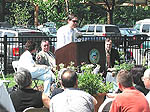
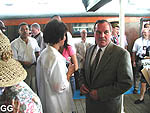
"The opening of this historic station is further proof of the CTA's commitment to providing riders with on-time, clean, safe, and friendly service for all riders," said Mayor Daley. "Residents and visitors alike can see the continuing economic revitalization of the City's south and east sides."
"By carefully preserving elements of the station at Homan for reuse here, we've combined an important part of the past with the technological advances of the 21st Century "L" service," said CTA Chairman Valerie Jarrett. "This inviting facility will provide rail access to the community, academic activities at Lucy Flower Career Academy, cultural events at the Garfield Park Field House and flower shows at the Conservatory."
CTA President Kruesi added, "With the opening of this new station, we can look forward to another ridership boost for the Green Line, which has bounced back since it was closed for a two-year rehabilitation in 1994."
As a special treat, the CTA's Historic Cars, 4000-series unit 4271-4272, which the CTA only brings out on special occasions, were on hand for the opening ceremony. A ride was given to the dignitaries and members of the public, departing the outbound platform at the conclusion of the ceremony and returning to the inbound platform. After the train ride, Mayor Daley was given a tour of the station facility by CTA Executive Vice President Jack Hartman and other CTA officials, during which the mayor expressed his satisfaction with the job the CTA had done on both the historic facility and the opening ceremonies. These events were followed by a reception for invited guests and the public at the adjacent Garfield Park Conservatory.
A New Historic Station...
The Conservatory-Central Park Drive station is certainly an unusual one, with the integration of the 1893 Queen Anne metal station houses from the former Homan station. The station provides easy access to the East Garfield Park community, directly to the north, and to the Park District's Gold Dome Field House to the south and Garfield Park Conservatory to the north.
The station has twin station houses and side platforms for boarding eastbound and westbound trains. Elevators to both platforms provide full accessibility to customers with disabilities, and full-length canopies offer protection from inclement weather. The station houses and portions of the canopies on both platforms are historically preserved components from the former station at Homan (3400 West) that have been restored and improved for reuse at the new facility.
 The inbound (south) station house, looking southeast from the west end of the outbound platform. The station's Queen Anne styling is evident. For a larger view, click here. (Photo by Graham Garfield) |
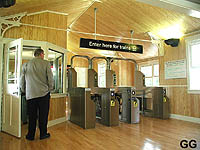 The interior of the inbound station house on June 30, 2001. The wood paneling and floors are reproductions, but much of the white metal hardware is original. The CA booth is on the left, in front of CTA VP of Rail Operations William Mooney. For a larger view, click here. (Photo by Graham Garfield) |
The station has two elevators for ADA access (one to each platform) and an overhead transfer bridge (for CAs only, similar to the one at Pulaski one stop west). There are two stairs to the station houses -- as opposed to the four in the original design at Homan -- with one for each side and both on the west side of Conservatory Drive/Central Park Drive. There are auxiliary stairs at the east end of the side platforms, one block east at Central Park Avenue (not to be confused with Central Park Drive, where the main entrance is), with entrance (with Transitcard only) and exit through high-barrier gates. Other improvements include a customer assistant kiosk in the inbound station (the outbound station house lacks one and only half of it is used for the public), and communication, public address, and HVAC systems. The platforms have tactile edging on both platforms, an ADA graphics package, and audiovisual signs to alert customers when trains are approaching. Inside the fare collection area of each station house are two Transit Card Vending Machines, two standard turnstiles, including one that accepts coins, and a wheelchair gate turnstile for customers with disabilities.
In September 2002, the Chicago Transit Authority has received the American Public Transportation Association's (APTA) Innovation Award for the design and restoration work carried out at the Conservatory-Central Park Drive station. The award was presented at APTA's Annual Meeting in Las Vegas. On October 22, 2002, the Chicago Transit Authority welcomed the Garfield Park Conservatory Alliance as the newest participant in the Adopt-A-Station Program. CTA® President Frank Kruesi, Chicago Park District General Superintendent David Doig and representatives from the Chicago Park District, Conservatory, and community leaders were on hand for the celebration announcing the Alliance's adoption of Conservatory station. The Conservatory Alliance contributed artwork to the station that depicts various recreational activities offered by Garfield Park and its Gold Dome field house, as well as images based on the plant collections in the Conservatory and Dale Chihulys Garden of Glass exhibit. The bases of the station elevators and some of the stations support columns are decorated with mosaics created by a group of teens from Chicago's West Side who worked under the direction of Carolyn Elaine from Chicago Public Art Group. BP America Inc., The National Endowment for the Arts, Gallery 37 and the City of Chicago Department of Cultural Affairs supported the project. On Friday, November 3, 2006, representatives from the Garfield Park Conservatory installd two 8.5" x 11" plaques in the unpaid area of the station as part of their adoption of the station. |
 |
conservatory02.jpg
(87k) |
 |
conservatoryAuxExitS.jpg
(79k) |
 |
conservatory06.jpg
(87k) |
 |
conservatory10.jpg
(101k) |
 |
conservatory11.jpg
(95k) |
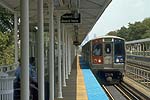 |
cta2527.jpg |
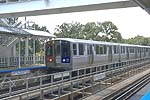 |
cta2442c.jpg |
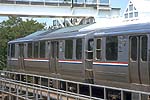 |
cta2464.jpg |
 |
cta4272e.jpg |
![]()
![]()
|
|